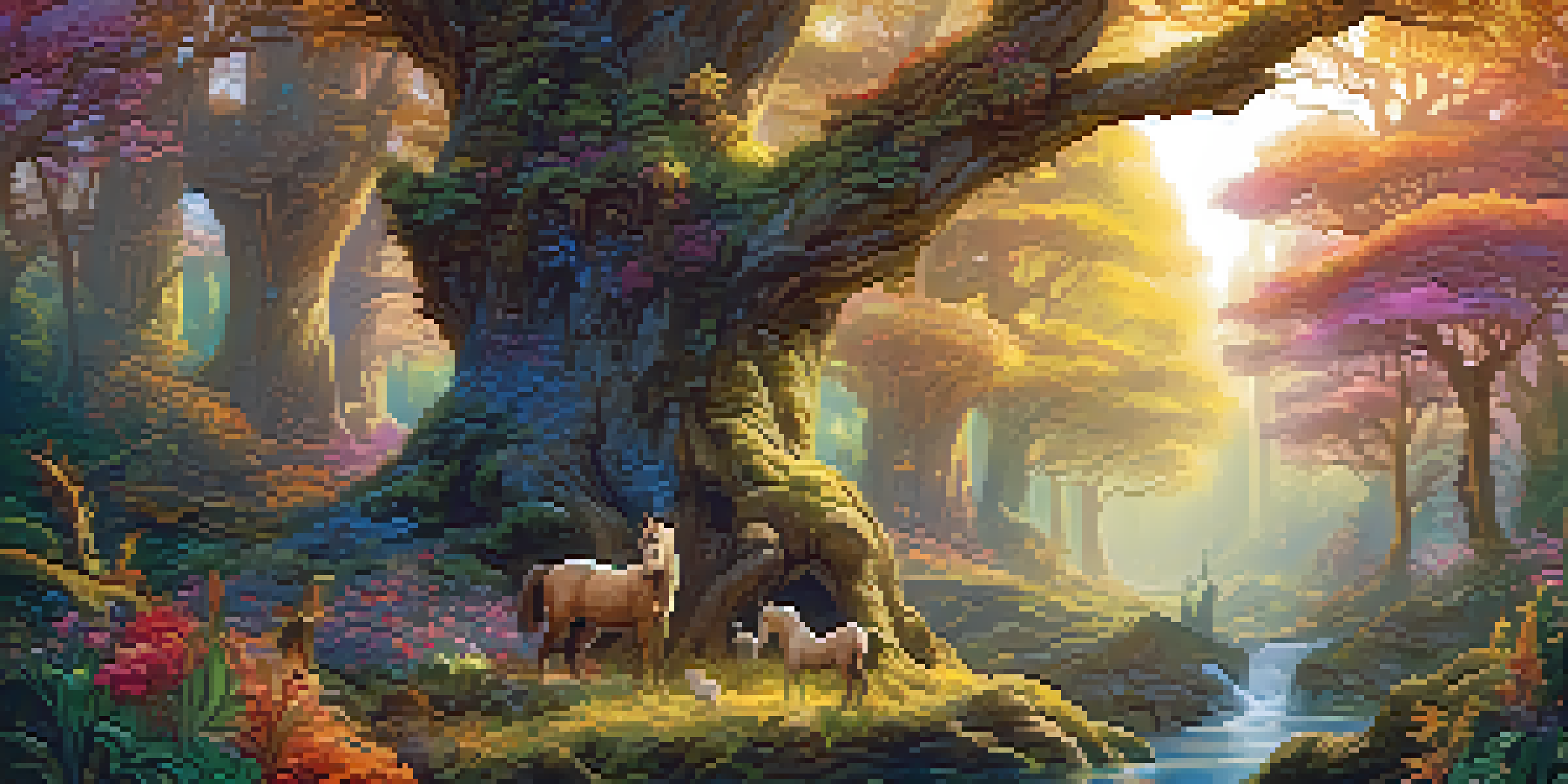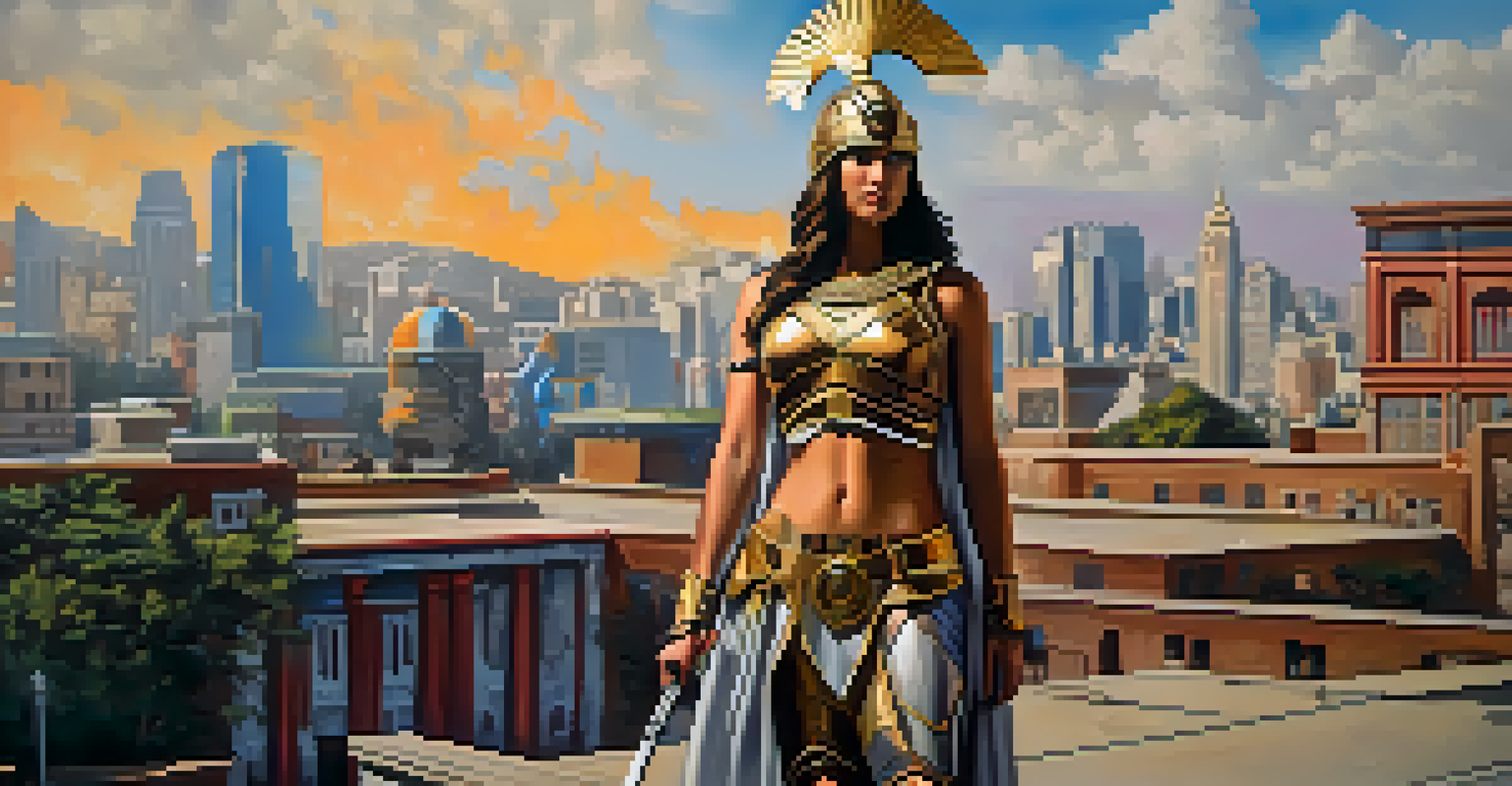The Influence of Mythology on Symbolism in Art

Understanding Mythology and Its Cultural Significance
Mythology serves as a foundational element in many cultures, offering stories and symbols that shape beliefs and values. These narratives often reflect the human experience, addressing universal themes like love, conflict, and morality. For instance, Greek mythology includes characters like Zeus and Athena, who represent different facets of life and human nature.
Mythology is not a lie; it is a belief, a faith, a way of seeing the world.
The rich tapestry of myths provides artists with a vast reservoir of imagery and motifs to draw from. This connection between mythology and art transcends time, influencing various art movements and styles. By tapping into these age-old tales, artists can create works that resonate deeply with audiences, evoking emotions and thoughts that are often timeless.
In essence, mythology is not just about ancient stories; it is a lens through which we can interpret the world. The symbols and themes found in these myths continue to inspire contemporary artists, encouraging them to explore new interpretations and meanings. This ongoing dialogue between myth and art enriches both fields, fostering creativity and cultural understanding.
The Role of Symbols in Art and Their Meaning
Symbols are powerful tools in art, serving as visual shorthand to convey complex ideas and emotions. They can represent everything from personal experiences to collective cultural narratives. For example, a simple image of a dove often symbolizes peace, while a snake might represent danger or transformation.

Artists often use symbols derived from mythology to add depth and layers of meaning to their work. The incorporation of mythological symbols allows viewers to connect with the art on multiple levels, drawing on their own interpretations and understanding. This interaction between the artwork and the audience creates a dynamic experience that can evoke a range of emotions.
Mythology Shapes Art and Culture
Mythology serves as a foundational element in many cultures, offering timeless stories and symbols that influence artistic expression and societal values.
Moreover, the use of symbols can bridge the gap between different cultures and eras. When an artist incorporates elements from various mythologies, it opens a dialogue that transcends geographical boundaries, inviting viewers to explore universal themes. This blending of influences not only enriches the artwork but also fosters a sense of shared human experience.
Iconic Examples of Mythology in Art History
Throughout art history, numerous artists have drawn inspiration from mythology, creating iconic works that resonate with viewers. For instance, Sandro Botticelli's 'The Birth of Venus' is steeped in mythological symbolism, depicting the goddess Venus emerging from the sea. This painting captures the essence of beauty and love, inviting viewers to explore deeper meanings.
Art is the most beautiful of all lies; it is a lie that reveals the truth.
Similarly, Pablo Picasso's 'Guernica' incorporates symbolic imagery that reflects the chaos and suffering of war, drawing from the mythology of human conflict. The painting serves as a powerful political statement, using mythological references to highlight the universality of suffering. Such works demonstrate how mythology can be a vehicle for social commentary and emotional expression.
These examples highlight the enduring influence of mythology on artistic expression across different periods and styles. By weaving mythological elements into their work, artists can create pieces that are not only visually stunning but also rich in meaning. This relationship between mythology and art continues to inspire new generations of creators.
Modern Interpretations of Mythological Themes
In today's art scene, contemporary artists are reinterpreting mythological themes through a modern lens. This approach allows for fresh perspectives on age-old stories, making them relevant to current societal issues. For instance, artists like Kehinde Wiley incorporate elements from classical mythology while addressing themes of race and identity.
By blending traditional mythological motifs with contemporary styles, these artists invite viewers to engage with the past while reflecting on the present. This fusion creates a dialogue that challenges viewers to reconsider their perceptions of mythology and its relevance today. It also opens up discussions about cultural appropriation and representation in art.
Symbols Enhance Artistic Meaning
Symbols derived from mythology add depth to art, allowing viewers to connect on multiple levels and facilitating a dynamic interaction with the artwork.
Furthermore, modern technology enables artists to explore these themes in innovative ways. Digital art, installations, and mixed media allow for an expansive interpretation of mythological narratives, reaching wider audiences. This evolution signifies that mythology remains a vital source of inspiration, capable of adapting to the changing landscape of art.
Symbolism in Literature and Its Artistic Influence
Literature and art have long been intertwined, with authors using symbolism to convey deeper meanings. Mythological references in literature can serve as a springboard for visual artists, prompting them to explore these themes in their work. For instance, the works of writers like Homer and Dante have inspired countless paintings, sculptures, and illustrations.
These literary symbols often translate into visual art through allegorical representations. An example is Dante's 'Divine Comedy,' which has inspired various artists to depict scenes of heaven, hell, and purgatory, using rich symbolism to evoke profound emotions. The interplay between literature and art allows for a richer understanding of both forms of expression.
Additionally, the symbolism found in literature helps artists tap into shared cultural narratives, making their work more relatable. By referencing literary myths, artists can create a sense of familiarity that resonates with audiences on a personal level. This connection fosters a deeper appreciation for both the literary and artistic worlds.
The Impact of Cultural Exchange on Symbolism
Cultural exchange has played a significant role in shaping the symbolism found in art. As societies interact and share ideas, the symbols from one culture can influence another, leading to new interpretations and meanings. This blending of cultures often results in a rich tapestry of artistic expression that reflects our interconnectedness.
For instance, the influence of Eastern mythology on Western art can be seen in the works of artists like Gustav Klimt, who incorporated elements from Japanese art. This cross-pollination enriches the artistic landscape, allowing for a diverse range of symbols and themes to emerge. It highlights the importance of cultural appreciation and understanding in the evolution of art.
Modern Artists Reinterpret Myths
Contemporary artists are reimagining mythological themes, blending traditional motifs with modern issues to create relevant and thought-provoking works.
Moreover, the globalized world we live in today continues to foster this exchange of ideas. Artists are now able to access a wealth of cultural symbols from around the globe, allowing them to create works that reflect a multitude of perspectives. This ongoing dialogue between cultures not only enhances creativity but also encourages a deeper understanding of our shared human experience.
Looking Ahead: The Future of Mythology in Art
As we move into the future, the influence of mythology on art is likely to continue evolving. Artists will undoubtedly find new ways to reinterpret and incorporate mythological themes, reflecting the changing dynamics of society. This ongoing exploration presents exciting possibilities for creative expression and cultural commentary.
Emerging technologies, such as virtual reality and augmented reality, may provide new platforms for artists to engage with mythology and symbolism. These innovations can create immersive experiences that transport viewers into mythological worlds, allowing for a deeper connection to the art. Such advancements could revolutionize how we experience and understand artistic symbolism.

Ultimately, the relationship between mythology and art will remain a vibrant and vital part of our cultural landscape. By continuing to explore these themes, artists can inspire future generations to engage with the rich narratives of the past while fostering an appreciation for the complexities of the human experience. The journey of mythology in art is far from over, and its impact will undoubtedly resonate for years to come.